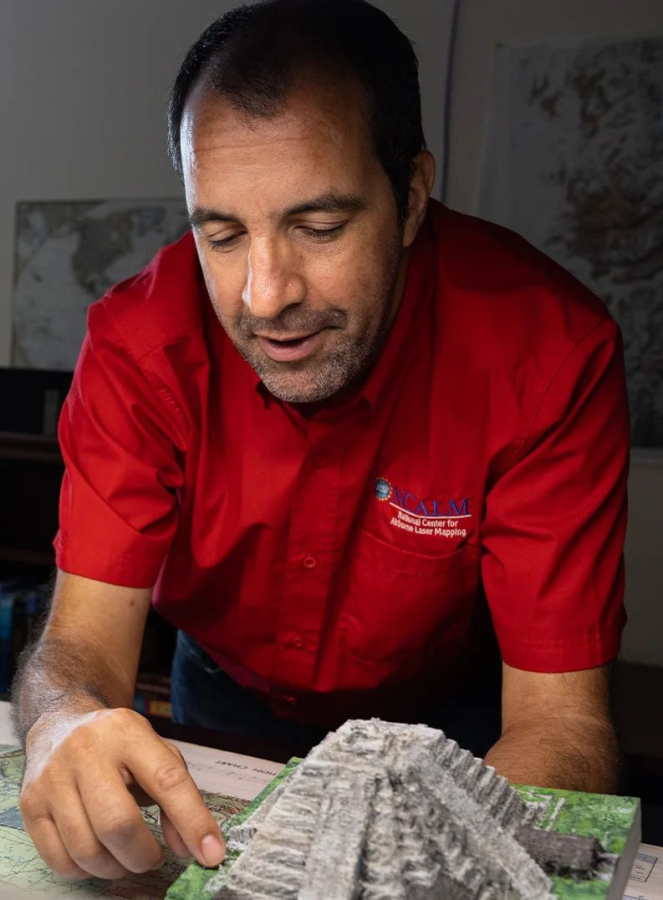In the ongoing quest to unearth the world’s hidden mysteries, University of Houston researchers and archaeology partners have discovered a lost Maya city deep in the jungles of Campeche, on the Yucatan Peninsula, in Mexico.
Notable among the findings were several 50-foot-tall structures, resembling pyramids, and pottery that dates the city to the Late Classic period, between the years 600 and 800.
Though undeniably rare and incredibly fascinating, finding the city, now dubbed Ocomtún, or stone column in Maya, is all in a day’s work for the experts at the National Center for Airborne Laser Mapping (NCALM) at UH.
In other words, it’s what they do.
Their track record includes finding ruins in 2012 in an area of Eastern Honduras where centuries-old legends talk of a “lost white city”; the 2016 mapping of more than 80,000 Maya structures including many previously unknown Maya settlements; and agricultural and defensive structures in the Guatemalan Peten jungle.
In terms of exploration, NCALM researchers get the first bite at the apple. Flying high above sites of interest, their plane armed with airborne light detection and ranging (lidar) equipment, they scan the vast array of landforms.
Lidar allows unprecedented data collection in areas that are extremely difficult to enter on foot, like deep within jungles and rainforests.
“You can compare us to ultrasound technicians. We are the first to see the baby, but the doctor will tell you all about it and confirm the findings,” said Juan Carlos Fernandez-Diaz, co-principal investigator of NCALM, housed in the Cullen College of Engineering, where he is also a research assistant professor of civil and environmental engineering.
Using lidar technology, Fernandez-Diaz and his team shoots hundreds of thousands of laser bursts per second at the ground and measures how quickly those pulses hit the ground and bounce back to their source. Those calculations reveal the exact distance between the plane and the ground. By repeating that process several billion times, the explorers create a three-dimensional map, complete with topographical markings noting rising structures and other hidden gems.
Then the NCALM staff hands over the findings to the archeologists for interpretation. In this project, the lead archeologist was Ivan Ṡprajc of the Slovenian Academy of Sciences and Arts under the auspices of Mexico's National Institute for Anthropology and History (INAH).
Ṡprajc confirmed the finding of three plazas complete with large buildings and a ball game field. The team was most surprised that the terrain was elevated and surrounded by wetlands. That’s where they found the pyramid-shaped buildings.
“The site served as an important center at the regional level,” Ṡprajc said in a statement released by INAH.
The Maya civilization is widely recognized as one of the magnificent societies in the Western Hemisphere. They gained renown for their awe-inspiring pyramid temples and impressive stone structures, which were located in what is now known as southern Mexico, Guatemala, Belize, Honduras and El Salvador.
To deliver the findings, the UH team took only three flights over the region, four hours each. Stunning findings for 12 hours of work, and though modest, Fernandez-Diaz admits NCALM has earned its reputation.
“For Mexico and Central America, we are the premier research center that has been able to do this quickly and affordably. We have over 10 years of these kinds of these discoveries,” Fernandez-Diaz said.
NCALM has been based at UH since 2010, operated jointly with the University of California at Berkeley. Researchers use laser mapping, satellite data analysis and other technologies to produce high-quality scientific data in a variety of fields, including archaeology, homeland security, environmental studies and natural disaster surveillance.
For Fernandez-Diaz, nothing beats opening a window and peering into another world, century or civilization.
"When we see it on the computer we think, ‘Wow!’ We are seeing these things for the first time in 1,000 years. It’s like time travel to see under the vegetation, to the roads, canals and ponds as they were that long ago,” he said.
